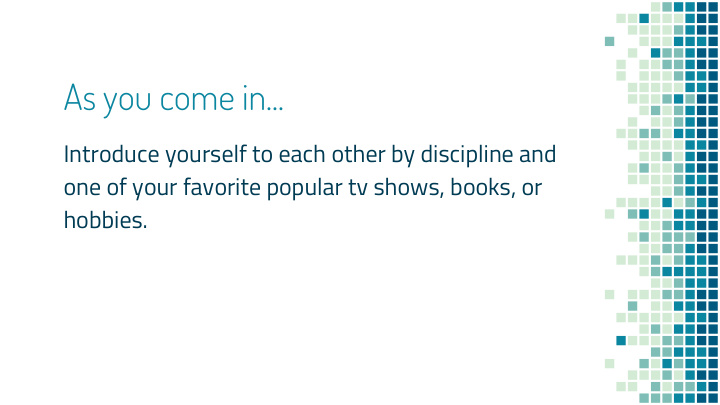



As you come in... Introduce yourself to each other by discipline and one of your favorite popular tv shows, books, or hobbies.
Inspiring Motivation through Theory-Based Lesson Planning Applying Malone’s Gaming Concepts Alan N. Witt Brandon K. West Research Instruction Librarian Head of Research Instruction Services SUNY Geneseo SUNY Geneseo witt@geneeo.edu westb@geneeo.edu
How many times have you hoped for this...
Only to get this...
Goals for today ▪ To give you tools to build intrinsically engaging lessons that students will remember long after college ▪ To apply those tools to a lesson plan
Grist for the mill ▪ At your tables, give a brief outline of a lesson plan that bombed ▫ Specifically, one in which the students were not engaged at all with the material
Theory of Intrinsically Motivating Instruction ▪ Thomas Malone (1981); connected to his studies of computer gaming Challenge ▫ Fantasy ▫ Curiosity ▫
Challenge ▪ Uncertain outcomes ▪ Ability to set difficulty levels ▪ Self-esteem When a student is challenged and succeeds ▫ through the struggle, their self-esteem can increase (Malone, 1981)
Fantasy ▪ Change the context of the situation “Evokes mental images of things not present ▫ to the sense or within the actual experience of the person involved” (Malone, 1981, p. 360) ▪ Intrinsic vs. Extrinsic Skill linked to fantasy vs. unlinked ▫ ▪ Sensory vs. Cognitive
Curiosity ▪ “One of the most important features of intrinsically motivating environments is the degree to which they can continue to arouse and then satisfy our curiosity” (Malone, 1981, p. 337) ▪ Self esteem not involved ▪ Randomized feedback
Group Activity ▪ At your tables, create a broad outline of a lesson plan using the element of Fantasy. Use the following prompt as a base: ▪ Your students have a writing assignment 5 pages long which must use credible sources. Topic can be one of {analyze a historical event; current events in a discipline; produce a professional piece of writing like a white paper, project plan, or report}
Background ▪ INTD 105, a required intro to writing course ▪ Required research paper & library session ▪ Course focus varies by professor depending on their discipline ▪ INTD 105: Sex, Skulls, and Aliens (Anthropology) ▫ Piltdown Man Hoax
Original iteration of the session Active learning ▪ Groups worked together to investigate a Piltdown Man Hoax ▪ suspect, specifically: Motive - Why would the suspect create the hoax? ● Expertise - What is the suspect an expert in? ● Opportunity - When/how/why could he have gotten away ● with it? They would present and discuss their findings to the class ▪
New Goals ▪ Students will engage more critically with the material ▪ Students will have an active discussion with each other throughout the class ▪ The session will be fun and gamified
Our Planning Process
What Students Actually Did …
Our Planning Process ▪ Fantasy: Scandal, Historical Intervention Team ▫ ▪ Challenge: Each team had a person to protect and a ▫ target to “slander” Selecting and evaluating sources ▫ ▪ Curiosity: No right answers ▫
Facilitating Discussion ▪ Target / Protectee debate ▪ Librarian-led discussion post debate ▫ Questioned students about intentional use of sources
Outcomes of Revised Session ▪ The students were engaged in thinking about credibility of their sources ▪ The students actively debated each other ▪ Several students offered (unprompted) that this was the most fun they’d had in a library instruction class ▪ The professor was thrilled; students were better prepared for upcoming lessons
Sliding scale of implementation ▪ Low end: Use just one element, or keep it low key ▪ High end: Full fantasy throughout the class ▫ Criminology where students process crime scenes in class and conclude with a trial.
Individual Exercise ▪ Using a lesson plan you brought with you, the lesson plan that bombed that you talked about earlier, or the prompt we worked on previously... ▪ Modify it to use the principles of intrinsic motivation (Challenge, Fantasy, and Curiosity), or anything else you gleaned from this presentation.
Questions?
Concepts you can apply ▪ Take a risk with instructional strategies ▫ Don’t be afraid to fail ▪ Be selective with these elements ▫ Pick out ones that fit your students and your class structure and apply piecemeal ▪ Be collaborative ▫ Plan out potential lessons with colleagues. ▪
References Malone, T. W. (1981). Toward a theory of intrinsically motivating instruction. Cognitive Science, 4 , 333-369.
Image References Apathetic students [Digital image]. (2016). Using group work to promote deep learning The Washington Post . Retrieved from [Digital image]. The Oscillation . Retrieved https://www.washingtonpost.com from http://theoscillation.com/group-projects-for- Laramie Animal Welfare Society. (2018). college-students/ Answer your cats question day [Digital image]. Retrieved from Photos on slides 14 and 17 were taken by http://laramieanimals.org/event/answer-you Brandon West. -cats-question-day/ Scandal Promotional Poster [Digital image]. (2017). Retrieved from https://en.wikipedia.org/wiki/Scandal_(seas on_6)
Recommend
More recommend